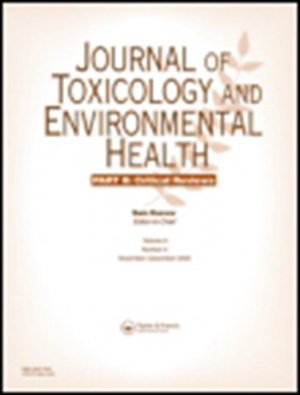Experimental models of chemically induced Parkinson's disease in zebrafish at the embryonic larval stage: a systematic review.
IF 6.4
2区 医学
Q1 ENVIRONMENTAL SCIENCES
Journal of Toxicology and Environmental Health-Part B-Critical Reviews
Pub Date : 2023-05-19
DOI:10.1080/10937404.2023.2182390
引用次数: 4
Abstract
ABSTRACT Parkinson’s disease (PD) is a neurodegenerative disorder characterized by the loss of dopaminergic neurons in the substantia nigra that results in a decrease in dopamine levels, resulting in motor-type disturbances. Different vertebrate models, such as rodents and fish, have been used to study PD. In recent decades, Danio rerio (zebrafish) has emerged as a potential model for the investigation of neurodegenerative diseases due to its homology to the nervous system of humans. In this context, this systematic review aimed to identify publications that reported the utilization of neurotoxins as an experimental model of parkinsonism in zebrafish embryos and larvae. Ultimately, 56 articles were identified by searching three databases (PubMed, Web of Science, and Google Scholar). Seventeen studies using 1-methyl-4-phenyl-1,2,3,6-tetrahydropyridine (MPTP), 4 1-methyl-4-phenylpyridinium (MPP+), 24 6-hydroxydopamine (6-OHDA), 6 paraquat/diquat, 2 rotenone, and 6 articles using other types of unusual neurotoxins to induce PD were selected. Neurobehavioral function, such as motor activity, dopaminergic neuron markers, oxidative stress biomarkers, and other relevant parameters in the zebrafish embryo-larval model were examined. In summary, this review provides information to help researchers determine which chemical model is suitable to study experimental parkinsonism, according to the effects induced by neurotoxins in zebrafish embryos and larvae.斑马鱼胚胎幼体期化学诱导帕金森病的实验模型:系统综述。
帕金森病(PD)是一种神经退行性疾病,其特征是黑质中多巴胺能神经元的丧失,导致多巴胺水平下降,导致运动型障碍。不同的脊椎动物模型,如啮齿动物和鱼类,已被用于研究帕金森病。近几十年来,斑马鱼因其与人类神经系统的同源性而成为研究神经退行性疾病的潜在模型。在此背景下,本系统综述旨在识别报道神经毒素作为斑马鱼胚胎和幼虫帕金森病实验模型的出版物。最终,通过搜索三个数据库(PubMed, Web of Science和Google Scholar)确定了56篇文章。选取了17篇使用1-甲基-4-苯基-1,2,3,6-四氢吡啶(MPTP)、4篇使用1-甲基-4-苯基吡啶(MPP+)、24篇使用6-羟多巴胺(6- ohda)、6篇使用百草枯/双喹特、2篇鱼藤酮和6篇使用其他类型异常神经毒素诱导PD的研究。检测斑马鱼胚胎-幼体模型的神经行为功能,如运动活性、多巴胺能神经元标志物、氧化应激生物标志物及其他相关参数。综上所述,根据神经毒素对斑马鱼胚胎和幼虫的影响,本综述为研究人员确定适合研究实验性帕金森病的化学模型提供了信息。
本文章由计算机程序翻译,如有差异,请以英文原文为准。
求助全文
约1分钟内获得全文
求助全文
来源期刊
CiteScore
13.80
自引率
6.90%
发文量
13
审稿时长
>24 weeks
期刊介绍:
"Journal of Toxicology and Environmental Health: Part B - Critical Reviews" is an academic journal published by Taylor & Francis, focusing on the critical examination of research in the areas of environmental exposure and population health. With an ISSN identifier of 1093-7404, this journal has established itself as a significant source of scholarly content in the field of toxicology and environmental health.
Since its inception, the journal has published over 424 articles that have garnered 35,097 citations, reflecting its impact and relevance in the scientific community. Known for its comprehensive reviews, the journal also goes by the names "Critical Reviews" and "Journal of Toxicology & Environmental Health, Part B, Critical Reviews."
The journal's mission is to provide a platform for in-depth analysis and critical discussion of the latest findings in toxicology, environmental health, and related disciplines. By doing so, it contributes to the advancement of knowledge and understanding of the complex interactions between environmental factors and human health, aiding in the development of strategies to protect and improve public health.

 求助内容:
求助内容: 应助结果提醒方式:
应助结果提醒方式:


